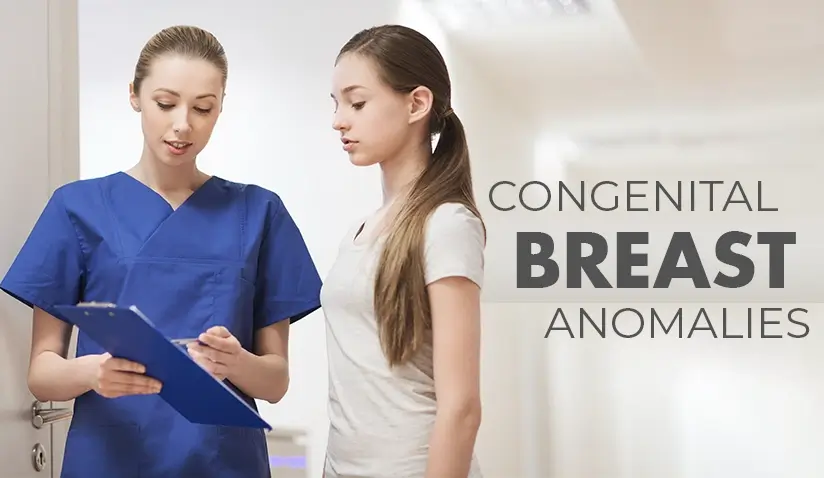Congenital Breast Anomalies: Types, Causes, Treatments

Congenital breast anomalies refer to a spectrum of irregularities in the breast's development that are present from birth. These anomalies can vary widely in terms of their presentation and severity, affecting one or both breasts. They encompass a range of conditions that can involve underdevelopment or overdevelopment, abnormalities in size and shape, as well as nipple malformation, such as inverted nipples or supernumerary (extra) nipples.
The significance of congenital breast anomalies extends beyond the physical aspect; these conditions can also have a profound psychological impact on individuals.
Therefore, it is important for those with congenital breast anomalies to know that help is available. Treatment approaches vary based on the type and severity of the anomaly and may range from surgical correction to psychological support.
Types of Congenital Breast Anomalies
Congenital breast anomalies can be classified into several categories based on the nature and characteristics of the anomaly.
Underdevelopment (Hypoplasia)
- Unilateral and Bilateral Hypoplasia: This condition involves underdeveloped breast tissue on one (unilateral) or both (bilateral) sides. It can range from mild to severe.
- Amastia: This is the absence of one or both breasts, a rare condition that may occur with or without the absence of the nipple and areola.
- Micromastia: Characterized by unusually small breasts, this condition is often subjective and diagnosed when a person's breasts are perceived as underdeveloped for their age and general body size.
- Poland Syndrome: A condition marked by the underdevelopment of the chest wall and muscles on one side of the body, often accompanied by related arm and hand anomalies.
- Tuberous Breasts: This condition results in small, rounded breasts resembling tubers or narrow cylinders, often with a large and puffy areola.
Overdevelopment (Hyperplasia)
- Hypertrophy: An enlargement of one or both breasts. Juvenile hypertrophy specifically refers to this condition when it occurs in adolescent females and can cause significant physical discomfort and emotional distress.
- Giant Fibroadenoma: A benign tumor that can cause significant enlargement of the breast tissue, often necessitating surgical removal.
- Gynecomastia: This condition refers to the overdevelopment of breast tissue in males and can be seen as a form of hyperplasia in this context.
Nipple Abnormalities
- Athelia: The absence of one or both nipples, a rare condition that can occur alone or with other breast anomalies.
- Polythelia: The presence of extra nipples, also known as supernumerary nipples, which can occur along the "milk lines" that run from the armpits to the groin.
- Nipple Inversion: This condition involves the inward retraction of the nipple, which can be congenital or acquired.
Other Anomalies
- Polymastia: The presence of additional breasts beyond the typical two. These accessory breasts can appear with or without nipples and areola and can be located anywhere along the milk lines.
Causes of Congenital Breast Anomalies
Genetic Factors
Several congenital breast anomalies have been linked to genetic factors, illustrating how inherited traits can influence breast development. For instance:
- Tuberous Breasts and Poland Syndrome are examples where genetics play a significant role. Tuberous breasts may result from a genetic mutation affecting breast tissue development, while Poland Syndrome is associated with mutations affecting the development of the chest muscle.
- Syndromic Causes: Certain genetic syndromes, such as Noonan Syndrome, Turner Syndrome, and Marfan Syndrome, have been associated with congenital breast anomalies. These conditions often involve complex genetic mutations or chromosomal abnormalities that can affect multiple body systems, including breast development.
Prenatal Influences
The environment within the womb, influenced by hormones or medications during pregnancy, can significantly impact the development of breast tissue:
- Hormonal Influences: Fluctuations in maternal hormones, such as estrogen and progesterone, can affect fetal breast tissue development. Excessive or deficient levels of these hormones may contribute to abnormalities.
- Medications: Certain medications taken during pregnancy, particularly those affecting hormonal balance, have been implicated in the development of breast anomalies. However, the evidence is often correlational, and direct causation can be difficult to establish.
Developmental Problems
Issues arising during the embryonic development of the breast and chest wall can lead to congenital anomalies:
- Abnormal Fetal Vasculature Development: The early embryonic blood supply is crucial for the development of all body tissues, including the breasts. Interruptions or abnormalities in this vascular network can lead to underdeveloped (hypoplastic) or absent (amastia) breast tissue.
- Abnormal Developmental Processes: The breast tissue develops from the ectodermal layer of the embryo along the milk lines. Any disruption in this process can result in anomalies such as polymastia or polythelia.
Diagnosis
Diagnosing congenital breast anomalies involves a comprehensive approach that combines physical examination with various diagnostic tests, imaging tests, and genetic testing.
Treating Congenital Breast Anomalies
The treatment of congenital breast anomalies is highly individualized, reflecting the wide range of conditions and each person's unique needs. Therefore, it is particularly important to consult a healthcare professional specializing in congenital breast anomalies who can provide individualized advice depending on the specific anomaly, the individual's age, overall health, and personal goals. Here is an overview of the various treatment options:
Observation
In some cases, observation may be the initial approach, especially if the anomaly is mild or detected in infancy or early childhood. This involves monitoring the anomaly over time to see if it resolves on its own or stabilizes. For example, minor cases of breast asymmetry or underdevelopment may become less noticeable as the individual grows and develops.
Surgery
Surgical intervention is a common treatment for more pronounced congenital breast anomalies and is tailored to the specific condition and desired outcome:
Breast Reconstruction Surgery: This procedure is crucial for conditions such as amastia, severe hypoplasia, or Poland Syndrome, where there is significant underdevelopment or absence of breast tissue. To recreate breast volume and shape, pedicled or free flaps may be used, allowing the transfer of tissue from one part of the body to the breast. Two-stage breast reconstruction involves the initial placement of a tissue expander, which is replaced later with a permanent implant, while single-stage correction may be possible in some cases. Dynamic muscle transfer and microsurgery techniques are often employed to ensure a natural-looking reconstruction.
Breast Augmentation: To address micromastia or unilateral hypoplasia, augmentation with implants or autologous fat transfer (lipofilling) is utilized. Augmentation mammoplasty typically involves the insertion of breast implants to enhance size and shape. Fat grafting offers a more natural alternative by using the patient's own fat cells to increase breast volume.
Reduction Mammoplasty: For hypertrophy or significant asymmetry, reduction mammoplasty can be performed to remove excess breast tissue and skin, achieving a size more proportionate to the individual's body frame. This procedure often incorporates tissue-sparing techniques to maintain as much natural tissue and function as possible.
Nipple Reconstruction Surgery: Nipple anomalies, such as athelia or severe nipple inversion, often involve nipple reconstruction, which can improve or recreate the appearance of the nipple-areola complex. This may include relocating the nipple-areola to a more aesthetically pleasing or anatomically correct position.
Additionally, for comprehensive chest wall reconstruction, options include thoracic wall reconstruction, pectoralis muscle reconstruction, and the use of breast prosthesis to achieve symmetry and a natural contour. Soft tissue transfer and bone grafts may be utilized to repair or reconstruct the chest wall and surrounding structures, ensuring both aesthetic and functional restoration.
Physical Therapy
Physical therapy can be beneficial, particularly for conditions like Poland Syndrome, where the chest wall muscles are underdeveloped. Exercises aimed at improving posture and strengthening the pectoralis muscle can help optimize the results of surgical treatment and improve overall chest appearance.
Latest Advancements
The field of reconstructive surgery, particularly for congenital breast anomalies, has seen significant advancements in recent years. These innovations aim to improve aesthetic outcomes, minimize surgical trauma, and enhance patient recovery. Here are some of the latest advancements:
Minimally Invasive Surgical Techniques for Breast Reconstruction
Recent developments have focused on surgical procedures that involve:
- Smaller incisions, reducing scarring and the risk of complications.
- Faster recovery, typically resulting in less postoperative pain and a quicker return to daily activities.
Personalized Reconstruction Using 3D Printing Technologies
3D printing technology has revolutionized personalized medicine, including breast reconstruction:
- Customized Implants and Surgical Guides: 3D printing can improve symmetry and outcomes in reconstructive surgery by incorporating customized implants and surgical guides tailored to the individual's anatomy.
- Tissue Engineering: There is also research into 3D bioprinting, which aims to create biocompatible structures that could one day be used for more natural breast reconstruction.
Advancements in Nipple and Areola Reconstruction Techniques
Surgical interventions for congenital breast anomalies have evolved to include a variety of sophisticated techniques:
- 3D Reconstruction Methods: Employing state-of-the-art 3D printing and modeling techniques to create a nipple-areola complex that matches the patient's anatomy and preferences in terms of size, shape, and color.
- Medical Tattooing: Advanced medical tattooing techniques are used to add detail and depth to the reconstructed nipple-areola complex, enhancing its natural appearance.
- Tissue Engineering: The development of bioengineered tissues that can be used to reconstruct the nipple-areola complex, offering an alternative to traditional surgical methods and potentially reducing the need for multiple surgeries.
- Customized Flaps and Grafts: The use of more refined and patient-specific pedicled or free flaps tailored to the unique contours and requirements of the nipple-areola area.
New Materials Under Development
Research into new materials aims to enhance the safety and effectiveness of breast reconstruction:
- Biocompatible Materials: New, more biocompatible materials are being developed for implants, reducing the risk of rejection and complications such as capsular contracture.
- Injectable Fillers: Advances in injectable fillers and fat grafting techniques are also noteworthy. These methods involve using the patient's own tissue or new materials that integrate more naturally with the body, offering improvements in safety and aesthetics.
Dr. Mireia Ruiz Castilla is the Head of the Plastic, Aesthetic, and Reconstructive Surgery Service at the Hospital Quirónsalud Barcelona. She has extensive experience in the medical-surgical management of breast pathology, cutaneous oncology, burns, facial fractures, hand surgery and alterations of skin coverage, both with the use of conventional as well as microsurgical techniques. Dr. Mireia has multiple presentations at international congresses to her credit and is the author of several publications in scientific journals. Forbes magazine ranked Dr. Mireia among the 5 best plastic surgeons in Spain in 2018, 2019, and 2020.
The Plastic, Aesthetic and Reconstructive Surgery unit at Quirónsalud Hospital is one of the top centers in Spain. Dr. Mireia Ruiz-Castilla and her team of experts offer the full spectrum of specialized reconstructive surgery to fix tubular breasts and other cosmetic breast deformities. Around 95% of patients who come to Dr. Ruiz-Castilla for breast reshaping surgery have some degree of tubular breast deformity. Quirónsalud’s plastic surgery referral center in Barcelona has a team of the best reconstructive surgeons who specialize in tubular breast correction. Surgeons use the latest evidence-based techniques to reconstruct tubular breasts while achieving natural and long-lasting results.
References:
Featured Blogs





